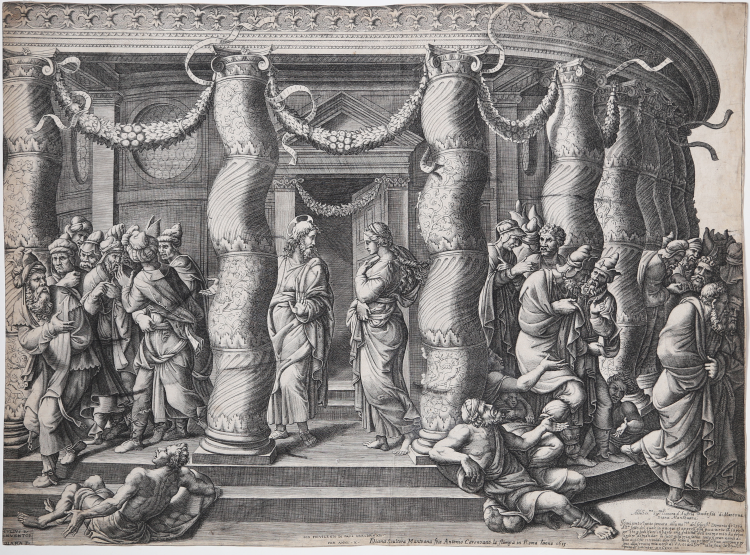



| Reference: | S24586 |
| Author | Diana SCULTORI |
| Year: | 1575 |
| Measures: | 567 x 415 mm |


| Reference: | S24586 |
| Author | Diana SCULTORI |
| Year: | 1575 |
| Measures: | 567 x 415 mm |
Engraving, 1575, inscribed and signed lower left: 'IVLIVS R./INVENTOR/DIANA F.', at centre: 'CON PRIVILEGIO DI PAPA GREGOR XXIII PER ANNI X', at right with a dedication to the Duchess of Mantua dated 1 September 1575.
Four state of ten, according to Bellini, inscribed at centre with publisher's address and date: 'Diana Scultora Mantoana fece Antonio Carenzano le stampa in Roma l'anno 1613'.
A great impression, printed with tone on contemporary laid paper, irregularly trimmed close to platemark, a repaired fold of paper in the middle, otherwise in very good condition.
After Giulio Romano's unknown drawing, which was, according to Massari in Giulio Romano Pinxit et Delineavit, no. 153, executed before he left Rome for Mantua. There is a drawn copy in the Louvre, inv. no. 3614. The setting is related to Raphael's St Peter and St John Healing the Cripples at the Gate of the Temple, among the Sistine tapestries.
Bellini notes that the print must have been realized before the inscribed date, as papal privilege was already assigned for it in June 1575.
E. Lincoln notes that (Making a Good Impression: Diana Mantuana’s Printmaking Career, in “Renaissance Quarterly”, vol. 50, n. 4, pp. 1101-1147):
The engraving was dedicated on 1 September 1575 to Eleonora of Austria, who, as wife of Duke Vincenzo Gonzaga, was the duchess of Mantua. On leaving, Diana was careful to reconfirm a beneficial connection, cautiously keeping bridges intact: “To her Serene Highness Lady Eleonora of Austria, Duchess of Mantua/ Diana Mantuana/ I feel my self so tied to the memory of Your Ladyship’s most fortunate dominion, under which I was born and learned what little virtù I possess, that to satisfy in part the gratitude in my soul I have been so bold as to bring this work of mine to light under her great name, in order that, returning to where it had its beginning, it serves her prince again, as a token of my service to Your Highness and your most serene house. From Rome, September 1, 1575”.
The design by Giulio Romano shows Christ and the young woman standing in the portico of a round temple framed by the twisting Byzantine columns which recall the ancient columns of St. Peter’s in Rome, but more specifically one of the tapestries Raphael and his workshop designed for the Sistine chapel. The scene of the Healing of the Cripple takes place amid just such columns: Giulio Romano evidently recycled the motif for Christ and the Adulteress, while the two seated figures at the foot of the stairs recall moments from another of the tapestries, The Death of Ananais. The Gonzaga were one of the private parties who had bought a set of the tapestries, woven from the same drawings as the papal originals, for their own palace. They were an ostentatious and extremely costly feature of the Mantuan’s palace decoration. The visual references to a specifically Gonzaga-related version of the heritage of Raphael and the connection to Vatican taste and wealth made an eloquent statement of Diana’s double allegiances to Mantua and to Rome. The dedicated print, once presented to the dedicatee, entered into a specific circuit of gift-giving and the reception of favors.
The impressive privilege, always in block letters to show its status as legal wording rather than the elegant letter-style cursive of the dedication, further endowed the print with an importance and desiderability that took in the wider circle of Mantuan and Roman nobility.
|
Bartsch XV.434.4 (II/II); Le Blanc II.292.14; Bellini, n. 21; Giulio Romano Pinxit et Delineavit, n. 153 (III/VI).
|
Diana SCULTORI (Mantova ante 1530- Roma 1588)
|
Diana Scultori, also known as Mantovana or erroneously Ghisi, was daughter of Giovan Battista and sister of Adamo. She was born in Mantua before 1530. In Mantua, she got married to Francesco, an architect from Volterra, whom she met after 1566, when Cesare Gonzaga had hired him to decorate his studio for the medals (which he embellished with ebony and ivory). After her marriage, Diana started signing her works as Diana Mantuana, civis Volterrana incidebat, to underline the fact that she had become citizen of that renowned city.
She lived and worked in Rome from 1575, signing her works as “civis volterrana”. Here she died in 1588.
In Rome she engraved drawings of Raphael and other Roman Mannerists.
Bartsch ascribes to her 47 prints, Passavant 59.
|
|
Bartsch XV.434.4 (II/II); Le Blanc II.292.14; Bellini, n. 21; Giulio Romano Pinxit et Delineavit, n. 153 (III/VI).
|
Diana SCULTORI (Mantova ante 1530- Roma 1588)
|
Diana Scultori, also known as Mantovana or erroneously Ghisi, was daughter of Giovan Battista and sister of Adamo. She was born in Mantua before 1530. In Mantua, she got married to Francesco, an architect from Volterra, whom she met after 1566, when Cesare Gonzaga had hired him to decorate his studio for the medals (which he embellished with ebony and ivory). After her marriage, Diana started signing her works as Diana Mantuana, civis Volterrana incidebat, to underline the fact that she had become citizen of that renowned city.
She lived and worked in Rome from 1575, signing her works as “civis volterrana”. Here she died in 1588.
In Rome she engraved drawings of Raphael and other Roman Mannerists.
Bartsch ascribes to her 47 prints, Passavant 59.
|